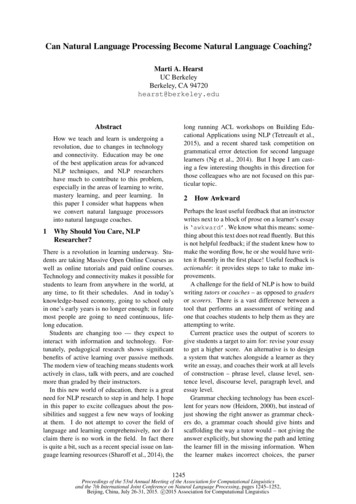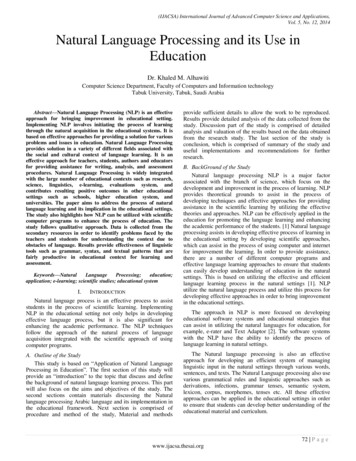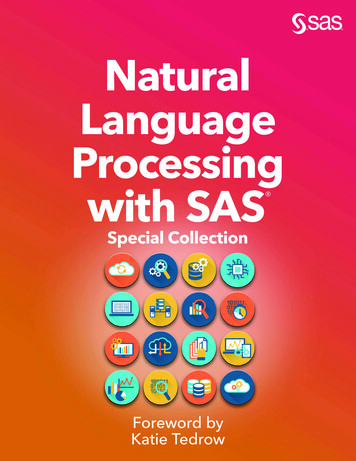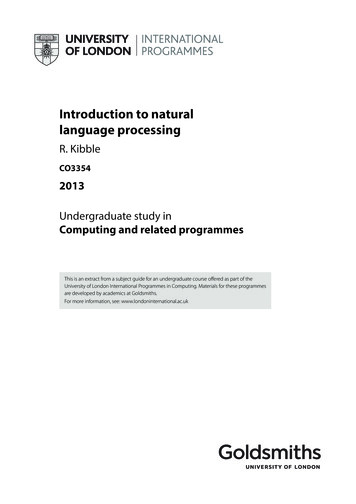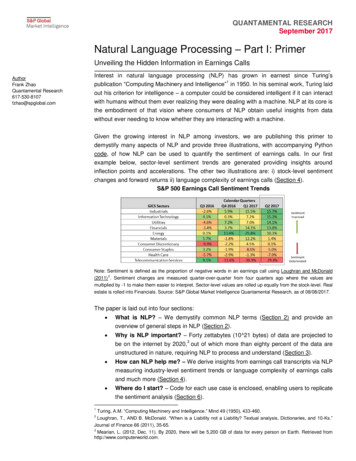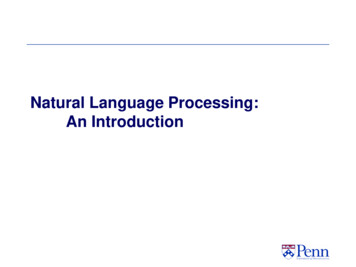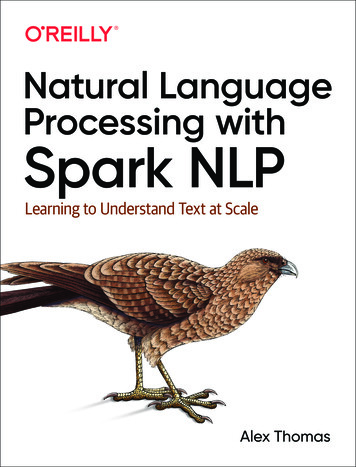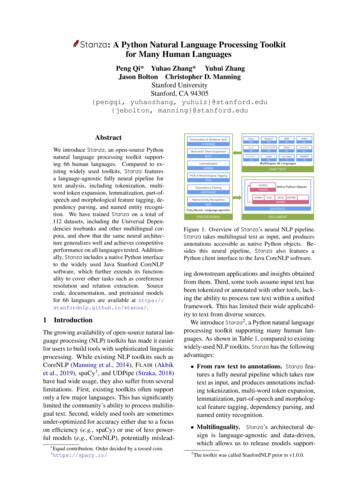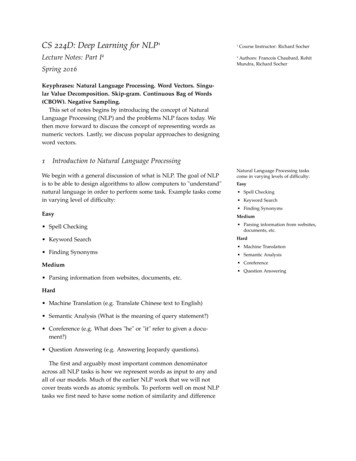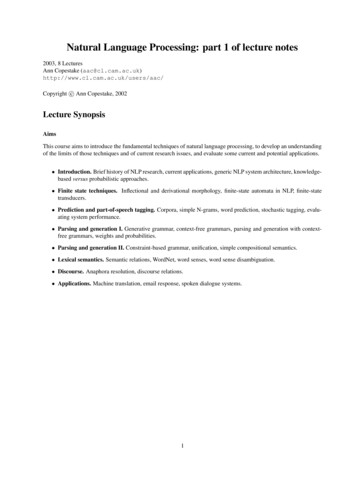
Transcription
Natural Language Processing: part 1 of lecture notes2003, 8 LecturesAnn Copestake c/Copyright c Ann Copestake, 2002Lecture SynopsisAimsThis course aims to introduce the fundamental techniques of natural language processing, to develop an understandingof the limits of those techniques and of current research issues, and evaluate some current and potential applications. Introduction. Brief history of NLP research, current applications, generic NLP system architecture, knowledgebased versus probabilistic approaches. Finite state techniques. Inflectional and derivational morphology, finite-state automata in NLP, finite-statetransducers. Prediction and part-of-speech tagging. Corpora, simple N-grams, word prediction, stochastic tagging, evaluating system performance. Parsing and generation I. Generative grammar, context-free grammars, parsing and generation with contextfree grammars, weights and probabilities. Parsing and generation II. Constraint-based grammar, unification, simple compositional semantics. Lexical semantics. Semantic relations, WordNet, word senses, word sense disambiguation. Discourse. Anaphora resolution, discourse relations. Applications. Machine translation, email response, spoken dialogue systems.1
ObjectivesAt the end of the course students should: be able to describe the architecture of and basic design for a generic NLP system ‘shell’ be able to discuss the current and likely future performance of several NLP applications, such as machinetranslation and email response be able to briefly describe a fundamental technique for processing language for several subtasks, such as morphological analysis, syntactic parsing, word sense disambiguation etc (as indicated in the lecture synopses). understand how these techniques draw on and relate to other areas of (theoretical) computer science, such asformal language theory, formal semantics of programming languages, or theorem proving.NLP is a large and multidisciplinary field, so this course can only provide a very general introduction. The firstlecture is designed to give an overview of the main subareas and a very brief idea of the main applications andthe methodologies which have been employed. The history of NLP is briefly discussed as a way of putting this intoperspective. The next six lectures describe some of the main subareas in more detail. The organisation is roughly basedon increased ‘depth’ of processing, starting with relatively surface-oriented techniques and progressing to consideringmeaning of sentences and meaning of utterances in context. Each lecture will consider the subarea as a whole and thengo on to describe one or more sample algorithms which tackle particular problems. The algorithms have been chosenbecause they are relatively straightforward to describe and because they illustrate a specific technique which has beenshown to be useful, but the idea is to exemplify an approach, not to give a detailed survey (which would be impossiblein the time available). However, other approaches will sometimes be discussed briefly. The final lecture brings thepreceding material together in order to describe the state of the art in three sample applications.There are various themes running throughout the lectures. One theme is the connection to linguistics and the tensionthat sometimes exists between the predominant view in theoretical linguistics and the approaches adopted within NLP.A somewhat related theme is the distinction between knowledge-based and probabilistic approaches. Evaluation willbe discussed in the context of the different algorithms.Because NLP is such a large area, there are many topics that aren’t touched on at all in these lectures. Speechrecognition and speech synthesis is almost totally ignored. Information retrieval and information extraction are thetopic of a separate course given by Simone Teufel, for which this course is a prerequisite.Since this is the first time I’ve given this course, the handout has been largely written from scratch and no doubtcontains many typos, bugs, infelicities and incomprehensible bits. Feedback would be greatly appreciated.Recommended ReadingBackground:Pinker, S., The Language Instinct, Penguin, 1994.This is a thought-provoking and sometimes controversial ‘popular’ introduction to linguistics. Although the NLPlectures don’t assume any exposure to linguistics, the course will be easier to follow if students have some idea of thelinguistic notion of a grammar, for instance.Recommended Book:Jurafsky, Daniel and James Martin, Speech and Language Processing, Prentice-Hall, 2000 (referenced as J&M throughout this handout).2
Study and Supervision GuideThe handouts and lectures should contain enough information to enable students to adequately answer the examquestions, but the handout is not intended to substitute for a textbook. In most cases, J&M go into a considableamount of further detail: rather than put lots of suggestions for further reading in the handout, in general I haveassumed that students will look at J&M, and then follow up the references in there if they are interested. The notesat the end of each lecture give details of the sections of J&M that are relevant and details of any discrepancies withthese notes. Manning and Schütze, ‘Foundations of Statistical Natural Language Processing’, MIT Press, 1999, is alsorecommended for further reading for the statistical aspects, especially word sense disambiguation.Supervisors ought to familiarize themselves with the relevant parts of Jurafsky and Martin (see notes at the end ofeach lecture). However, good students should find it quite easy to come up with questions that the supervisors (andthe lecturer) can’t answer! Language is like that . . .Generally I’m taking a rather informal/example-based approach to concepts such as finite-state automata, context-freegrammars etc. Part II students should have already got the formal background that enables them to understand theapplication to NLP. Diploma and Part II (General) students may not have covered all these concepts before, but theexpectation is that the examples are straightforward enough so that this won’t matter too much.This course inevitably assumes some very basic linguistic knowledge, such as the distinction between the major partsof speech. It introduces some linguistic concepts that won’t be familiar to all students: since I’ll have to go throughthese quickly, reading the first few chapters of an introductory linguistics textbook may help students understand thematerial. The idea is to introduce just enough linguistics to motivate the approaches used within NLP rather than toteach the linguistics for its own sake. Exam questions won’t rely on students remembering the details of any specificlinguistic phenomenon.Although these notes are almost completely new, prior year exam questions are still generally appropriate.Of course, I’ll be happy to try and answer questions about the course or more general NLP questions, preferably byemail.3
1 Lecture 1: Introduction to NLPThe aim of this lecture is to give students some idea of the objectives of NLP. The main subareas of NLP will beintroduced, especially those which will be discussed in more detail in the rest of the course. There will be a preliminarydiscussion of the main problems involved in language processing by means of examples taken from NLP applications.This lecture also introduces some methodological distinctions and puts the applications and methodology into somehistorical context.1.1What is NLP?Natural language processing (NLP) can be defined as the automatic (or semi-automatic) processing of human language.The term ‘NLP’ is sometimes used rather more narrowly than that, often excluding information retrieval and sometimeseven excluding machine translation. NLP is sometimes contrasted with ‘computational linguistics’, with NLP beingthought of as more applied. Nowadays, alternative terms are often preferred, like ‘Language Technology’ or ‘LanguageEngineering’. Language is often used in contrast with speech (e.g., Speech and Language Technology). But I’m goingto simply refer to NLP and use the term broadly.NLP is essentially multidisciplinary: it is closely related to linguistics (although the extent to which NLP overtly drawson linguistic theory varies considerably). It also has links to research in cognitive science, psychology, philosophy andmaths (especially logic). Within CS, it relates to formal language theory, compiler techniques, theorem proving, machine learning and human-computer interaction. Of course it is also related to AI, though nowadays it’s not generallythought of as part of AI.1.2Some linguistic terminologyThe course is organised so that there are six lectures corresponding to different NLP subareas, moving from relatively‘shallow’ processing to areas which involve meaning and connections with the real world. These subareas looselycorrespond to some of the standard subdivisions of linguistics:1. Morphology: the structure of words. For instance, unusually can be thought of as composed of a prefix un-, astem usual, and an affix -ly. composed is compose plus the inflectional affix -ed: a spelling rule means we endup with composed rather than composeed. Morphology will be discussed in lecture 2.2. Syntax: the way words are used to form phrases. e.g., it is part of English syntax that a determiner such asthe will come before a noun, and also that determiners are obligatory with certain singular nouns. Formal andcomputational aspects of syntax will be discussed in lectures 3, 4 and 5.3. Semantics. Compositional semantics is the construction of meaning (generally expressed as logic) based onsyntax. Compositional semantics is discussed in lecture 5. This is contrasted to lexical semantics, i.e., themeaning of individual words, which is discussed in lecture 6.4. Pragmatics: meaning in context. This will come into lecture 7, although linguistics and NLP generally havevery different perspectives here.1.3Why is language processing difficult?Consider trying to build a system that would answer email sent by customers to a retailer selling laptops and accessoriesvia the Internet. This might be expected to handle queries such as the following: Has my order number 4291 been shipped yet? Is FD5 compatible with a 505G? What is the speed of the 505G?4
Assume the query is to be evaluated against a database containing product and order information, with relations suchas the following:ORDEROrder numberDate orderedDate SER: Has my order number 4291 been shipped yet?DB QUERY: order(number 4291,date shipped ?)RESPONSE TO USER: Order number 4291 was shipped on 2/2/02It might look quite easy to write patterns for these queries, but very similar strings can mean very different things,while very different strings can mean much the same thing. 1 and 2 below look very similar but mean somethingcompletely different, while 2 and 3 look very different but mean much the same thing.1. How fast is the 505G?2. How fast will my 505G arrive?3. Please tell me when I can expect the 505G I ordered.While some tasks in NLP can be done adequately without having any sort of account of meaning, others require thatwe can construct detailed representations which will reflect the underlying meaning rather than the superficial string.In fact, in natural languages (as opposed to programming languages), ambiguity is ubiquitous, so exactly the samestring might mean different things. For instance in the query:Do you sell Sony laptops and disk drives?the user may or may not be asking about Sony disk drives. We’ll see lots of examples of different types of ambiguityin these lectures.Often humans have knowledge of the world which resolves a possible ambiguity, probably without the speaker orhearer even being aware that there is a potential ambiguity.1 But hand-coding such knowledge in NLP applicationshas turned out to be impossibly hard to do for more than very limited domains: the term AI-complete is sometimesused (by analogy to NP-complete), meaning that we’d have to solve the entire problem of representing the world andacquiring world knowledge. The term AI-complete is intended somewhat jokingly, but conveys what’s probably themost important guiding principle in current NLP: we’re looking for applications which don’t require AI-completesolutions: i.e., ones where we can work with very limited domains or approximate full world knowledge knowledgeby relatively simple techniques.1.4Some NLP applicationsThe following list is not complete, but useful systems have been built for: spelling and grammar checking optical character recognition (OCR) screen readers for blind and partially sighted users1 I’lluse ‘hearer’ generally to mean the person who is on the receiving end, regardless of the modality of the language transmission: i.e.,regardless of whether it’s spoken, signed or written. Similarly, I’ll use speaker for the person generating the speech, text etc and utterance tomean the speech or text itself. This is the standard linguistic terminology, which recognises that spoken language is primary and text is a laterdevelopment.5
augmentative and alternative communication (i.e., systems to aid people who have difficulty communicatingbecause of disability) machine aided translation (i.e., systems which help a human translator, e.g., by storing translations of phrasesand providing online dictionaries integrated with word processors, etc) lexicographers’ tools information retrieval document classification (filtering, routing) document clustering information extraction question answering summarization text segmentation exam marking report generation (possibly multilingual) machine translation natural language interfaces to databases email understanding dialogue systemsSeveral of these applications are discussed briefly below. Roughly speaking, they are ordered according to the complexity of the language technology required. The applications towards the top of the list can be seen simply as aids tohuman users, while those at the bottom are perceived as agents in their own right. Perfect performance on any of theseapplications would be AI-complete, but perfection isn’t necessary for utility: in many cases, useful versions of theseapplications had been built by the late 70s. Commercial success has often been harder to achieve, however.1.5Spelling and grammar checkingAll spelling checkers can flag words which aren’t in a dictionary.(1)* The neccesary steps are obvious.(2)The necessary steps are obvious.If the user can expand the dictionary, or if the language has complex productive morphology (see §2.1), then a simplelist of words isn’t enough to do this and some morphological processing is needed. 2More subtle cases involve words which are correct in isolation, but not in context. Syntax could sort some of thesecases out. For instance, possessive its generally has to be followed by a noun or an adjective noun combination etc 3(3)* Its a fair exchange.2 Notethe use of * (‘star’) above: this notation is used in linguistics to indicate a sentence which is judged (by the author, at least) to be incorrect.? is generally used for a sentence which is questionable, or at least doesn’t have the intended interpretation. # is used for a pragmatically anomaloussentence.3 The linguistic term I’ll use for this is Nbar, properly written N. Roughly speaking, an NBar is a noun with all its modifers (adjectives etc) butwithout a determiner.)6
(4)It’s a fair exchange.(5)* The dog came into the room, it’s tail wagging.(6)The dog came into the room, its tail wagging.But, it sometimes isn’t locally clear whether something is an Nbar or not: e.g. fair is ambiguous between a noun andan adjective.(7)* ‘Its fair’, was all Kim said.(8)‘It’s fair’, was all Kim said.(9)* Every village has an annual fair, except Kimbolton: it’s fair is held twice a year.(10)Every village has an annual fair, except Kimbolton: its fair is held twice a year.The most elaborate spelling/grammar checkers can get some of these cases right, but none are anywhere near perfect.Spelling correction can require a form of word sense disambiguation:(11)# The tree’s bows were heavy with snow.(12)The tree’s boughs were heavy with snow.Getting this right requires an association between tree and bough. In the past, attempts might have been made tohand-code this in terms of general knowledge of trees and their parts. But these days machine learning techniquesare generally used to derive word associations from corpora:4 this can be seen as a substitute for the fully detailedworld knowledge, but may actually be a more realistic model of how humans do word sense disambiguation. However,commercial systems don’t (yet) do this systematically.Simple subject verb agreement can be checked automatically:(13)* My friend were unhappy.But this isn’t as straightforward as it may seem:(14)A number of my friends were unhappy.(15)The number of my friends who were unhappy was amazing.(16)My family were unhappy.Whether the last example is grammatical or not depends on your dialect of English: it is grammatical for most BritishEnglish speakers, but not for many Americans.Checking punctuation can be hard (even AI-complete):BBC News Online, 3 October, 2001Students at Cambridge University, who come from less affluent backgrounds, are being offered up to1,000 a year under a bursary scheme.Thissentence contains a non-restrictive relative clause: a form of parenthetical comment. The sentence implies thatmost/all students at Cambridge come from less affluent backgrounds. What the reporter probably meant was a restrictive relative:Students at Cambridge University who come from less affluent backgrounds are being offered up to 1,000a year under a bursary scheme.If you use a word processor with a spelling and grammar checker, try looking at its treatment of agreement and someof these other phenomena. If possible, try switching settings between British English and American English.4Acorpus is a body of text that has been collected for some purpose, see §3.1.7
1.6Information retrieval, information extraction and question answeringInformation retrieval involves returning a set of documents in response to a user query: Internet search engines are aform of IR. However, one change from classical IR is that Internet search now uses techniques that rank documentsaccording to how many links there are to them (e.g., Google’s PageRank) as well as the presence of search terms.Information extraction involves trying to discover specific information from a set of documents. The informationrequired can be described as a template. For instance, for company joint ventures, the template might have slots forthe companies, the dates, the products, the amount of money involved. The slot fillers are generally strings.Question answering attempts to find a specific answer to a specific question from a set of documents, or at least a shortpiece of text that contains the answer.(17)What is the capital of France?Paris has been the French capital for many centuries.There are some question-answering systems on the Web, but most use very basic techniques. For instance, Ask Jeevesrelies on a fairly large staff of people who search the web to find pages which are answers to potential questions. Thesystem performs very limited manipulation on the input to map to a known question. The same basic technique is usedin many online help systems.1.7Machine translationMT work started in the US in the early fifties, concentrating on Russian to English. A prototype system was publiclydemonstrated in 1954 (remember that the first electronic computer had only been built a few years before that). MTfunded got drastically cut in the US in the mid-60s and ceased to be academically respectable in some places, butSystran was providing useful translations by the late 60s. Systran is still going (updating it over the years is anamazing feat of software engineering): Systran now powers AltaVista’s BabelFishhttp://world.altavista.com/and many other translation services on the web.Until the 80s, the utility of general purpose MT systems was severely limited by the fact that text was not available inelectronic form: Systran used teams of skilled typists to input Russian documents.Systran and similar systems are not a substitute for human translation: they are useful because they allow people toget an idea of what a document is about, and maybe decide whether it is interesting enough to get translated properly.This is much more relevant now that documents etc are available on the Web. Bad translation is also, apparently, goodfor chatrooms.Spoken language translation is viable for limited domains: research systems include Verbmobil, SLT and CSTAR.1.8Natural language interfaces and dialogue systemsNatural language interfaces were the ‘classic’ NLP problem in the 70s and 80s. LUNAR is the classic example ofa natural language interface to a database (NLID): its database concerned lunar rock samples brought back from theApollo missions. LUNAR is described by Woods (1978) (but note most of the work was done several years earlier): itwas capable of translating elaborate natural language expressions into database queries.SHRDLU (Winograd, 1973) was a system capable of participating in a dialogue about a microworld (the blocks world)and manipulating this world according to commands issued in English by the user. SHRDLU had a big impact on theperception of NLP at the time since it seemed to show that computers could actually ‘understand’ language: theimpossibility of scaling up from the microworld was not realized.LUNAR and SHRDLU both exploited the limitations of one particular domain to make the natural language understanding problem tractable, particularly with respect to ambiguity. To take a trivial example, if you know your databaseis about lunar rock, you don’t need to consider the music or movement senses of rock when you’re analysing a query.There have been many advances in NLP since these systems were built: systems have become much easier to build,and somewhat easier to use, but they still haven’t become ubiquitous. Natural Language interfaces to databases were8
commercially available in the late 1970s, but largely died out by the 1990s: porting to new databases and especially tonew domains requires very specialist skills and is essentially too expensive (automatic porting was attempted but neversuccessfully developed). Users generaly prefered graphical interfaces when these became available. Speech inputwould make natural language interfaces much more useful: unfortunately, speaker-independent speech recognitionstill isn’t good enough for even 1970s scale NLP to work well. Techniques for dealing with misrecognised datahave proved hard to develop. In many ways, current commercially-deployed spoken dialogue systems are using preSHRDLU technology.1.9Some more historyBefore the 1970s, most NLP researchers were concentrating on MT as an application (see above). NLP was a veryearly application of CS and started about the same time as Chomsky was publishing his first major works in formallinguistics (Chomskyan linguistics quickly became dominant, especially in the US). In the 1950s and early 1960s,ideas about formal grammar were being worked out in linguistics and algorithms for parsing natural language werebeing developed at the same time as algorithms for parsing programming languages. However, most linguists wereuninterested in NLP and the approach that Chomsky developed turned out to be only somewhat indirectly useful forNLP.NLP in the 1970s and first half of the 1980s was predominantly based on a paradigm where extensive linguistic andreal-world knowledge was hand-coded. There was controversy about how much linguistic knowledge was necessaryfor processing, with some researchers downplaying syntax, in particular, in favour of world knowledge. NLP researchers were very much part of the AI community (especially in the US and the UK), and the debate that went on inAI about the use of logic vs other meaning representations (‘neat’ vs ‘scruffy’) also affected NLP. By the 1980s, severallinguistic formalisms had appeared which were fully formally grounded and reasonably computationally tractable, andthe linguistic/logical paradigm in NLP was firmly established. Unfortunately, this didn’t lead to many useful systems,partly because many of the difficult problems (disambiguation etc) were seen as somebody else’s job (and mainstreamAI was not developing adequate knowledge representation techniques) and partly because most researchers were concentrating on the ‘agent-like’ applications and neglecting the user aids. Although the symbolic, linguistically-basedsystems sometimes worked quite well as NLIDs, they proved to be of little use when it came to processing less restricted text, for applications such as IE. It also became apparent that lexical acquisition was a serious bottleneck forserious development of such systems.Statistical NLP became the most common paradigm in the 1990s, at least in the research community. Speech recognition had demonstrated that simple statistical techniques worked, given enough training data. NLP systems werebuilt which required very limited hand-coded knowledge, apart from initial training material. Most applications weremuch shallower than the earlier NLIDs, but the switch to statistical NLP coincided with a change in US funding,which started to emphasize speech-based interfaces and IE. There was also a general realization of the importanceof serious evaluation and of reporting results in a way that could be reproduced by other researchers. US fundingemphasized competitions with specific tasks and supplied test material, which encouraged this, although there was adownside in that some of the techniques developed were very task-specific. It should be emphasised that there hadbeen computational work on corpora for many years (much of it by linguists): it became much easier to do corpuswork by the late 1980s as disk space became cheap and machine-readable text became ubiquitous. Despite the shiftin research emphaisis to statistical approaches, most commercial systems remained primarily based on hand-codedlinguistic information.More recently the symbolic/statistical split has become less pronounced, since most researchers are interested in both. 5There is considerable emphasis on machine learning in general, including machine learning for symbolic processing.Linguistically-based NLP has made something of a comeback, with increasing availability of open source resources,and the realisation that at least some of the classic statistical techniques seem to be reaching limits on performance,especially because of difficulties in adapting to new types of text. However, the modern linguistically-based approachesare making use of machine learning and statistical processing. The dotcom boom and bust has considerably affectedNLP, but it’s too early to say what the long-term implications are. The ubiquity of the Internet has certainly changedthe space of interesting NLP applications, and the vast amount of text available can potentially be exploited, especiallyfor statistical techniques.5 At least, there are only a few researchers who avoid statistical techniques as a matter of principle and all statistical systems have a symboliccomponent!9
1.10Generic ‘deep’ NLP application architectureMany NLP applications can be adequately implemented with relatively shallow processing. For instance, spellingchecking only requires a word list and simple morphology to be useful. I’ll use the term ‘deep’ NLP for systems thatbuild a meaning representation (or an elaborate syntactic representation), which is generally agreed to be required forapplications such as NLIDs, email question answering and good MT.The most important principle in building a successful NLP system is modularity. NLP systems are often big softwareengineering projects — success requires that systems can be improved incrementally.The input to an NLP system could be speech or text. It could also be gesture (multimodal input or perhaps a SignLanguage). The output might be non-linguistic, but most systems need to give some sort of feedback to the user, evenif they are simply performing some action (issuing a ticket, paying a bill, etc). However, often the feedback can bevery formulaic.There’s general agreement that the following system components can be described semi-independently, although assumptions about the detailed nature of the interfaces between them differ. Not all systems have all of these components: input preprocessing: speech recogniser or text preprocessor (non-trivial in languages like Chinese or for highlystructured text for any language) or gesture recogniser. Such system might themselves be very complex, but Iwon’t discuss them in this course — we’ll assume that the input to the main NLP component is segmented text. morphological analysis: this is relatively well-understood for the most common languages that NLP has considered, but is complicated for many languages (e.g., Turkish, Basque). part of speech tagging: not an essential part of most deep processing systems, but sometimes used as a way ofcutting down parser search space. parsing: this includes syntax and compositional semantics, which are sometimes treated as separate components disambiguation: this can be done as part of parsing, or (partially) left to a later phase context module: this maintains information about the context, for anaphora resolution, for instance. text planning: the part of language generation that’s concerned with deciding what meaning to convey (I won’tdiscuss this in this course) tactical generation: converts meaning representations to strings. This may use the same grammar and lexicon 6as the parser
Natural language processing (NLP) can be dened as the automatic (or semi-automatic) processing of human language. The term ‘NLP’ is sometimes used rather more narrowly than that, often excluding information retrieval and sometimes even excluding machine translation. NLP is sometimes contrasted with ‘
